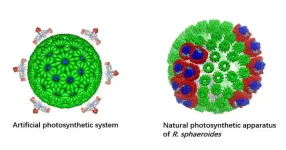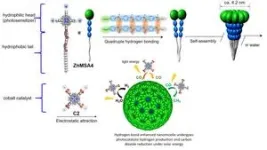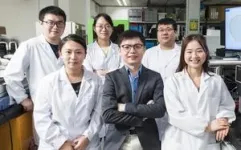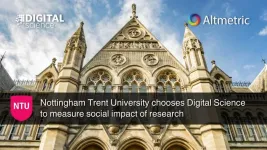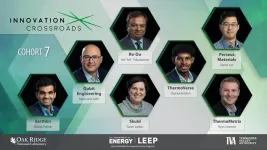(Press-News.org) A joint research team from City University of Hong Kong (CityU) and collaborators recently developed a stable artificial photocatalytic system that is more efficient than natural photosynthesis. The new system mimics a natural chloroplast to convert carbon dioxide in water into methane, a valuable fuel, very efficiently using light. This is a promising discovery, which could contribute to the goal of carbon neutrality.
Photosynthesis is the process by which chloroplasts in plants and some organisms use sunlight, water and carbon dioxide to create food or energy. In past decades, many scientists have tried to develop artificial photosynthesis processes to turn carbon dioxide into carbon-neutral fuel.
“However, it is difficult to convert carbon dioxide in water because many photosensitizers or catalysts degrade in water,” explained Professor Ye Ruquan, Associate Professor in the Department of Chemistry at CityU, one of the leaders of the joint study. “Although artificial photocatalytic cycles have been shown to operate with higher intrinsic efficiency, the low selectivity and stability in water for carbon dioxide reduction have hampered their practical applications.”
In the latest study, the joint-research team from CityU, The University of Hong Kong (HKU), Jiangsu University and the Shanghai Institute of Organic Chemistry of the Chinese Academy of Sciences overcame these difficulties by using a supramolecular assembly approach to create an artificial photosynthetic system. It mimics the structure of a purple bacteria’s light-harvesting chromatophores (i.e. cells that contain pigment), which are very efficient at transferring energy from the sun.
The core of the new artificial photosynthetic system is a highly stable artificial nanomicelle – a kind of polymer that can self-assemble in water, with both a water-loving (hydrophilic) and a water-fearing (hydrophobic) end. The nanomicelle’s hydrophilic head functions as a photosensitizer to absorb sunlight, and its hydrophobic tail acts as an inducer for self-assembly. When it is placed in water, the nanomicelles self-assemble due to intermolecular hydrogen bonding between the water molecules and the tails. Adding a cobalt catalyst results in photocatalytic hydrogen production and carbon dioxide reduction, resulting in the production of hydrogen and methane.
Using advanced imaging techniques and ultrafast spectroscopy, the team unveiled the atomic features of the innovative photosensitizer. They discovered that the special structure of the nanomicelle’s hydrophilic head, along with the hydrogen bonding between water molecules and the nanomicelle’s tail, make it a stable, water-compatible artificial photosensitizer, solving the conventional instability and water-incompatibility problem of artificial photosynthesis. The electrostatic interaction between the photosensitizer and the cobalt catalyst, and the strong light-harvesting antenna effect of the nanomicelle improved the photocatalytic process.
In the experiment, the team found that the methane production rate was more than 13,000μmol h−1 g−1, with a quantum yield of 5.6% over 24 hours. It also achieved a highly efficient solar-to-fuel efficiency rate of 15%, surpassing natural photosynthesis.
Most importantly, the new artificial photocatalytic system is economically viable and sustainable, as it doesn’t rely on expensive precious metals. “The hierarchical self-assembly of the system offers a promising bottom-up strategy to create a precisely controlled, high-performance artificial photocatalytic system based on cheap, Earth-abundant elements, like zinc and cobalt porphyrin complexes,” said Professor Ye.
Professor Ye said he believes the latest discovery will benefit and inspire the rational design of future photocatalytic systems for carbon dioxide conversion and reduction using solar energy, contributing to the goal of carbon neutrality.
The findings were published in the scientific journal "Nature Catalysis" under the title “Artificial spherical chromatophore nanomicelles for selective CO2 reduction in water”.
The first authors are Dr Yu Junlai, from the Shanghai Institute of Organic Chemistry, and Dr Huang Libei, CityU PhD. The corresponding authors are Professor Ye, Professor David Lee Philips, from HKU, Professor Du Lili, from Jiangsu University, and Professor Tian Jia, from the Shanghai Institute of Organic Chemistry.
The study was supported by various funding sources, including the National Natural Science Foundation of China, the Guangdong Basic and Applied Basic Research Fund, the Shenzhen Science and Technology Program, and the Hong Kong Research Grant Council.
https://www.cityu.edu.hk/research/stories/2023/08/03/new-photocatalytic-system-converts-carbon-dioxide-valuable-fuel-more-efficiently-natural-photosynthesis
END
New photocatalytic system converts carbon dioxide to valuable fuel more efficiently than natural photosynthesis
2023-08-03
ELSE PRESS RELEASES FROM THIS DATE:
Association of pregnancy-specific alcohol policies with infant morbidities and maltreatment
2023-08-03
About The Study: In this study of 1.4 million birthing person–infant pairs in the U.S., most pregnancy-specific alcohol policies were not associated with decreased odds of infant injuries or morbidities. Policy makers should not assume that pregnancy-specific alcohol policies improve infant health.
Authors: Sarah C. M. Roberts, Dr.P.H., of the University of California, San Francisco, is the corresponding author.
To access the embargoed study: Visit our For The Media website at this link https://media.jamanetwork.com/
(doi:10.1001/jamanetworkopen.2023.27138)
Editor’s ...
Nottingham Trent University chooses Digital Science to measure social impact of research
2023-08-03
Digital Science, a technology company serving stakeholders across the research ecosystem, is pleased to announce that Nottingham Trent University has chosen Altmetric Explorer from Digital Science’s flagship products to improve the measurement and reporting of social media and alternative metrics.
Nottingham Trent University (NTU) has signed a deal to utilise Altmetric to report on societal impact and dissemination of research.
Using Digital Science’s products and tools, NTU will be able to support its research strategy, impact development, dissemination ...
Seven entrepreneurs join Innovation Crossroads seventh cohort
2023-08-03
Seven entrepreneurs will embark on a two-year fellowship as the seventh cohort of Innovation Crossroads kicks off this month at the Department of Energy’s Oak Ridge National Laboratory. Representing a range of transformative energy technologies, Cohort 7 is a diverse class of innovators with promising new companies.
New to Innovation Crossroads’ sponsorship this year are DOE’s Office of Electricity and Office of Science Advanced Scientific Computing Research program, which join DOE’s Advanced Materials and Manufacturing Technologies Office, DOE’s Building Technologies Office, and the Tennessee ...
After 7 years, generative AI succeeds in predicting clinical trial outcomes
2023-08-03
Highlights:
Since its inception in 2014, Insilico Medicine has developed multiple AI models for predicting the probability of success of clinical trials focusing on Phase II to Phase III transition probabilities.
To validate the models, it pursued three strategies - retrospective, quasi-prospective, and prospective validation.
In 2016, it deposited on a preprint server the first date-stamped article with the predictions of clinical trials.
The publication titled “Prediction of clinical trials outcomes based on target choice and clinical trial design with multi‐modal artificial intelligence” ...
Study highlights importance of mineral iron in ocean ecosystems
2023-08-03
New research published today in Nature has revealed the importance of mineral forms of iron in regulating the cycling of this bio-essential nutrient in the ocean.
The findings pave the way for new work on the relationship between the iron and carbon cycles and how changing ocean oxygen levels may interact.
The study, led by the University of Liverpool and involving collaborators in the United States, Australia and France, addresses a knowledge gap in ocean research.
Principal Investigator Professor Alessandro Tagliabue said: “To date we have not fully appreciated ...
NUS study: A patchwork of Wnt signalling ligands and receptors pattern the colours on the wings of butterflies
2023-08-03
Wnt signalling is a well-known mode of cell-to-cell communication in multicellular biological organisms. It involves the secretion of small Wnt glycoproteins, by signalling cells, that bind to receptor proteins in the membrane of receiving cells. This signal modifies proteins on the inside of these receiving cells to make cells grow, divide or differentiate. This mode of communication is fundamental in both normal and altered cellular development, such as in cancer and wound healing, and has remained in the limelight ...
University of Ottawa research team finds window into mechanisms of rare disease
2023-08-03
A University of Ottawa-led research team has published rigorous new research that advances a quest to understand a puzzling – and heartbreaking – ultra-rare disease that’s found almost exclusively in boys.
XLP-2 is a genetic X-linked lymphoproliferative disease first described in 2006. It typically has severe complications among patients who become infected with the Epstein-Barr virus, an exceedingly common virus that infects most people without problems in their teenage years or young adulthood. But when the few individuals with XLP-2 encounter the Epstein-Barr virus the experience is often fatal ...
Three out of every ten meals ordered from the main food delivery app in Brazil come from dark kitchens
2023-08-03
About a third of the restaurants listed on iFood, the food delivery app most used by Brazilians, are “dark kitchens”, according to the first study of the topic conducted in Brazil, and one of only a few worldwide.
An article on the study is published in the journal Food Research International. It has eight authors; the first three and the last are researchers at the State University of Campinas (UNICAMP) in São Paulo state.
Defined in the article as delivery-only restaurants that have no direct contact with consumers, have no premises for local consumption and sell solely ...
Butterfly-inspired films create vibrant colors while passively cooling objects
2023-08-03
WASHINGTON —On a hot summer day, white clothing feels cooler than other colors due to reflecting—not absorbing—sunlight. Other colors like blue or black, will undergo a heating effect as they absorb light. To circumvent this heating effect in colored cooling films, researchers drew inspiration from nanostructures in butterfly wings.
The new films, which don’t absorb any light, could be used on the outside of buildings, vehicles and equipment to reduce the energy needed for cooling while preserving vivid color properties.
“In buildings, large amounts of energy are used for cooling and ventilation, and running ...
MIT Press's Direct to Open (D2O) achieves second year goal, opens access to 82 new books in 2023
2023-08-03
Thanks to the support of libraries participating in Direct to Open (D2O), the MIT Press will publish its full list (see below) of 2023 scholarly monographs and edited collections open access on the MIT Press Direct platform.
Launched in 2021, D2O is a sustainable framework that harnesses the collective power of libraries to support open and equitable access to vital, leading scholarship. D2O moves scholarly books from a solely market-based, purchase model, where individuals and libraries buy ...
